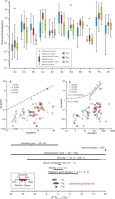Gold source and deposition in the Sanakham gold deposit, SW Laos: Constrains from textures, trace element geochemistry and in-situ sulfur isotopes of pyrite

The Luang Prabang (Laos) – Loei (Thailand) metallogenetic belt is endowed with major porphyry-skarn, and epithermal gold deposits. The Sanakham gold deposit is a newly discovered hydrothermal vein-type orogenic gold deposits (10.6 t Au @ 3.05 g/t) in the belt, and consist of a series of quartz-sulfide veins that are controlled by secondary structures of the regional NNE-trending brittle-ductile shear zone. Its mineralization can be divided into four stages: (I) quartz–pyrite–arsenopyrite, (II) quartz–pyrite–pyrrhotite–chalcopyrite, (III) quartz–pyrite–base-metal sulfide, and (IV) quartz–carbonate. Three pyrite generations were identified: py1 (stage I) as disseminated euhedral to subhedral coarse grains; py2 (stage II) as subhedral to anhedral fine grains occur around the cataclastic and corrosion textures in py1; py3 (stage III) as subhedral to anhedral fine grains occurred in sulfide veins or veinlets that overprint the existing quartz-sulfides. All three generations of pyrite have low trace-element contents including very low lattice-bound gold (py1: 0.040 ppm; py2: 0.098 ppm; py3: 0.028 ppm) and arsenic (py1: 227 ppm; py2: 133 ppm; py3: 13.3 ppm) contents. Visible gold grains are sited in textures of pyrite grains that relate to brittle cataclastic deformation. Considering the relatively low contents of pyrite in the ores of Sanakham, it is impossible to derive the high-gold grade orebodies through local remobilization of originally lattice-bound gold in pyrite. The py2 might be formed during hydrothermal overprinting and dissolution of py1 led by continuous supply of ore fluids with relatively higher contents of Au, Ag, Cu, Sb, Te, Pb, and Bi. A reduction reaction related to reduced carbon species in wallrock is an assignable cause for gold deposition, even though the fluid-rock interaction and fluid immiscibility processes might be important. The Au- and As-poor pyrites have similar δ34S values (py1: –2.58 to –0.83 ‰; py2: –2.17 ‰ to + 0.25 ‰; py3: –1.24 to –0.60 ‰ ppm) that close to 0 ‰, indicating the sulfur may have been originated from magmatic or mantle sources. Therefore, we propose that the Sankham gold deposit is a member of the orogenic deposit class, but notably characterized by the low concentrations of invisible gold in the relatively As-poor pyrite lattice.
Publisher URL: https://www.sciencedirect.com/science/article/pii/S0169136824001367
Open URL: https://doi.org/10.1016/j.oregeorev.2024.106003
DOI: 10.1016/j.oregeorev.2024.106003
Keeping up-to-date with research can feel impossible, with papers being published faster than you'll ever be able to read them. That's where Researcher comes in: we're simplifying discovery and making important discussions happen. With over 19,000 sources, including peer-reviewed journals, preprints, blogs, universities, podcasts and Live events across 10 research areas, you'll never miss what's important to you. It's like social media, but better. Oh, and we should mention - it's free.
Researcher displays publicly available abstracts and doesn’t host any full article content. If the content is open access, we will direct clicks from the abstracts to the publisher website and display the PDF copy on our platform. Clicks to view the full text will be directed to the publisher website, where only users with subscriptions or access through their institution are able to view the full article.


